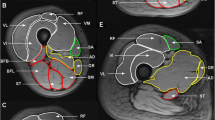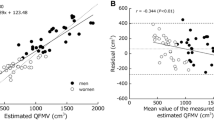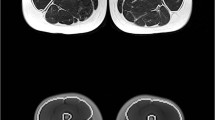Abstract
Muscle size is often reported as a single anatomical cross-sectional area (ACSA), rather than volume measured with contiguous MRI scans. However, a single ACSA may provide an inadequate estimate of muscle mass. Therefore, we investigated whether quadriceps muscle volume can be adequately estimated from a single ACSA. In 18 adult males we derived regression equations from which estimates of volume were made. These equations were based on the direct assessment of volume using 11 transverse-plane MRI scans along the entire length of the femur (the gold standard). We estimated volume based on single scans at 40, 50 and 60% of femur length (from the distal end). All estimates of quadriceps volumes were highly correlated to the measured volume and demonstrated a low level of error. R 2 = 0.84, 0.93, 0.90 (all P < 0.01), standard error of estimate (SEE) = 26.8 ± 5.2, 12.5 ± 5.4 and 9.9 ± 5.7%, for single scans taken at 40, 50 and 60% of femur length respectively. In comparison, when volume was estimated using multiple MRI scans corresponding to the maximum ACSA of each muscle the estimate was even better [R 2 = 0.95 (P < 0.01) and SEE = 4.5 ± 2.7%]. Substituting ACSA from a single MRI scan at 60% of femur length into a previously determined regression equation allows for an estimation of muscle volume with a 10% error of estimate.





Similar content being viewed by others
References
Berg HE, Tedner B, Tesch PA (1993) Changes in lower limb muscle cross-sectional area and tissue fluid volume after transition from standing to supine. Acta Physiologica Scandinavica 148:379–385
Esformes JI, Narici MV, Maganaris CN (2002) Measurement of human muscle volume using ultrasonography. Eur J Appl Physiol 87:90–92
Fukunaga T, Roy RR, Shellock FG, Hodgson JA, Day MK, Lee PL, Kwong-Fu H, Edgerton VR (1992) Physiological cross-sectional area of human leg muscles based on magnetic resonance imaging. J Orthop Res 10:928–934
Fukunaga T, Miyatani M, Tachi M, Kouzaki M, Kawakami Y, Kanehisa H (2001) Muscle volume is a major determinant of joint torque in humans. Acta Physiologica Scandinavica 172:249–255
Housh DJ, Housh TJ, Johnson GO, Chu WK (1992) Hypertrophic response to unilateral concentric isokinetic resistance training. J Appl Physiol 73:65–70
Jones PR, Pearson J (1969) Anthropometric determination of leg fat and muscle plus bone volumes in young males and female adults. J Physiol 204:63P–66P
Kanehisa H, Ikegawa S, Tsunoda N, Fukunaga T (1994) Strength and cross-sectional area of knee extensor muscles in children. Eur J Appl Physiol Occup Physiol 68:402–405
Kubo K, Kanehisa H, Azuma K, Ishizu M, Kuno SY, Okada M, Fukunaga T (2003) Muscle architectural characteristics in women aged 20–79 years. Med Sci Sports Exerc 35:39–44
Mark BA, Ste-Croix D, Deigham MA, Armstrong N (2003) Assessment and interpretation of isokinetic muscle strength during growth and maturation. Sports Med 33:727–743
Miyatani M, Kanehisa H, Kuno S, Nishijima T, Fukanaga T (2002) Validity of ultrasonograph muscle thickness measurements for estimating muscle volume of knee extensors in humans. Eur J Appl Physiol 86:203–208
Morse CI, Thom JM, Davis MG, Fox KR, Birch KM, Narici MV (2004) Reduced plantarflexor specific torque in the elderly is associated with a lower activation capacity. Eur J Appl Physiol 92:219–226
Narici M, Roi G, Landoni L, Minetti A, Cerretelli P (1989) Changes in force, cross-sectional area and neural activation during strength training and detraining of the human quadriceps. Eur J Appl Physiol Occup Physiol 59:310–319
Narici M, Landoni L, Minetti A (1992) Assessment of human knee extensor muscles stress from in vivo physiological cross-sectional area and strength measurements. Eur J Appl Physiol Occup Physiol 65:438–444
Narici MV, Hoppeler H, Kayser B, Landoni L, Claassen H, Gavardi C, Conti M, Cerretelli P (1996) Human quadriceps cross-sectional area, torque and neural activation during 6 months strength training. Acta Physiologica Scandinavica 157:175–186
Overend TJ, Cunningham DA, Paterson DH, Lefcoe MS (1992) Thigh composition in young and elderly men determined by computed tomography. Clin Physiol 12:629–640
Reeves ND, Maganaris CN, Narici MV (2004) Ultrasonographic assessment of human skeletal muscle size. Eur J Appl Physiol 91:116–118
Tothill P, Stewart AD (2002) Estimation of thigh muscle and adipose tissue volume using magnetic resonance imaging and anthropometry. J Sports Sci 20:563–567
Author information
Authors and Affiliations
Corresponding author
Rights and permissions
About this article
Cite this article
Morse, C.I., Degens, H. & Jones, D.A. The validity of estimating quadriceps volume from single MRI cross-sections in young men. Eur J Appl Physiol 100, 267–274 (2007). https://doi.org/10.1007/s00421-007-0429-4
Accepted:
Published:
Issue Date:
DOI: https://doi.org/10.1007/s00421-007-0429-4




